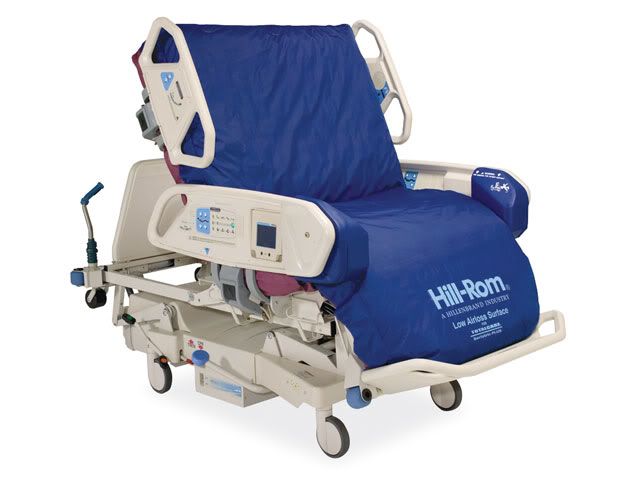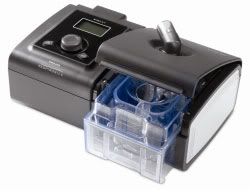
Bariatric Plus Bed, by Hill Rom
This is an Editorial from the fall 0f 2009 as published in the Wilkes Barre Times Leader, on a diagnosis , that from the veiwpoint of a Pulmonary/Critical Care/ Sleep physician, is starting to overwhelm medical services in the United States.
It was written for a local Northeastern Pennsylvania perspective, but I think it applies to most of the US if not the bulk of of the developed world.
Although it is often mentioned as a cause of rising health care costs, I’m not sure that the average person understands the true impact of the epidemic of obesity on the healthcare system. The statistics on obesity are available and sobering; 2/3rd of US adults are considered to be overweight. 33% of adults in the US are categorized as obese (Body mass index greater than 30 kg/m2), up from roughly 12% in 1962. Twenty years ago, when I started my practice, perhaps twice a year a patient would present that was too heavy for my 350 pound capacity scale. Now it would easily be twice a week; the scale in my office now accommodates 750 pound patients. I have personally cared for folks as heavy as 650 pounds.
Our affluent society has given us extraordinary access to high caloric foods. Fast food makes up an increasing percentage of our diets, and purveyors, keep inventing larger and more caloric offerings to entice us. Foods high in sugars and carbohydrates tend also to be the least expensive which partly explains why obesity rates in the US are higher among the poor. People are often just not aware of what they’re eating. A dozen chicken wings can actually equal a person’s total recommended caloric intake for the day. “All you can eat” buffets encourage a pattern of eating that can be potentially lethal to the wrong person.
We also lack perspective. When all your friends weight around 300 pounds, it may not seem terribly alarming to be approaching 400. I encounter this denial issue all the time. We sometimes have to confront people with the extraordinary degree of their obesity problem. It is not uncommon to have to remind a patient that they are three times their ideal body weight. Young people can be the most difficult to convince. When you are young man, you can manage a 300-400lb body without too much trouble. It is only later in life that such patients will develop the respiratory, back, hip, and knee issues that can be devastating.
It is well recognized that obesity leads to increased rates of diabetes, heart disease, malignancy, arthritis, and other health issues. A problem that is specific to my specialty (Pulmonary and Sleep Medicine) in the obese patient is Obstructive Sleep Apnea, a condition where breathing is interrupted during sleep by collapse of the patient’s airway. Treatment usually requires the purchase of a CPAP device, a small ventilator that pressurizes a patient’s airway during sleep, preventing this. This is expensive technology.
More expensive yet are the power chair and “scooters” increasingly provided to those whose weight, along with the inevitable arthritis of the knees and hips, makes them unable to walk.
At their “end stage”, patients become essentially immobile, unable to walk because of the orthopedic and respiratory problems. And because of their extreme weight, and complex medical problems they are often not considered to be a candidate for elective surgery such as joint replacement, because of the multiple risks associated with surgery in this population.
The respiratory system is affected by obesity in other ways. First, excess weight is an additional inescapable burden that must be carried about, increasing symptoms in anyone with an impaired cardiopulmonary status. Obesity tends to increase the severity of Asthma by both mechanical and metabolic effects.
Some obese patients will develop Restrictive Chest Wall Syndrome, which occurs when excessive soft tissue envelops the chest and inhibits the patient from utilizing their total lung volumes. An extreme form of the latter problem is referred to as Obesity Hypoventilation Syndrome. Also called “Pickwickian Syndrome” (named for a character in the Dickens novel The Pickwick Papers), the condition is usually linked to Obstructive Sleep Apnea, and in occurs when chest wall restriction is extreme, and the patient hypoventilates to a degree that they retain carbon dioxide in the bloodstream and can literally be “smothered” by their own adipose tissue. They will often respond to positive pressure therapy at night (similar to CPAP), and of course, significant weight loss.

BiPAP AVAPs by Phillips Respironics
Obesity has profoundly altered healthcare in hospitals. The obesity epidemic has forced healthcare facilities to purchase new, so-called “big boy” beds, chairs, lifts, and other equipment to deal with the burgeoning dimensions of our patients. Nursing staff bear s much of the burden of the epidemic. It is increasingly difficult for a single 150 pound female nurse to provide care to patients who are often more than double her weight.
Simple procedures such as even intravenous lines become difficult. Procedures such as central venous lines are even more problematic. These larger intravenous lines, often used in emergency situations, are placed using anatomic landmarks for guidance. As those landmarks are obscured in the obese patient, ultrasound imaging is now often necessary for successful placement. Even more troubling is that at some point, patients can become too heavy to undergo diagnostic test such as CT scans, for fear of breaking the scanner’s gantry, which could delay care for other patients.
Recently at John Heinz, morbidly obese patients were noted to be an increasing percentage of our inpatient and outpatient Pulmonary Rehabilitation Programs. This prompted us to create a unique Bariatric Respiratory program, utilizing our resources in Physical, Occupational and Respiratory Therapy, Respiratory Nursing Pool Therapy, and Dietetics. It is available to obese patients who have respiratory diagnoses such as those mentioned earlier in the article. Patients can be enrolled as inpatients, usually in transfer from an acute care hospital, or attend as outpatients. The program consists of special joint-sparing exercise training, education, occupational therapy and an intensive program of dietary counseling with the goal of improving the patients cardiovascular fitness, increasing muscle mass, and thus metabolic rate, and planning a diet for slow, healthy weight loss.
At Mercy Special Care Hospital, a Long Term Acute Care Hospital in Nanticoke, Pennsylvania, we have run a successful ventilator-weaning program for the last twelve years. There too, we have seen a shift from patients with diagnoses such as Acute Lung Injury, or end stage lung diseases such as COPD, to increasing numbers of patients whose ventilator dependence is due to Obesity Hypoventilation Syndrome. Over the last several years, we have had great success treating obese, ventilator dependent patients by using a rather simple protocol. We carefully control their caloric intake, using precise metabolic monitoring, and begin aggressive physical therapy to make these bedridden patients ambulatory once again. Generally, once they lose 15-20% of their body weight, and begin to walk, they can generally be liberated from the ventilator. Once liberated, they can be transitioned to home, or to the programs at John Heinz. Such patients, if they participate fully, can have literally life altering results.
If you are struggling with weight issues, there is help available. Besides the programs mentioned above, there are numerous resources on the web including sites such as Web MD and freedieting .com. The latter site has a calculator to establish your Body Mass Index, a rough guide to determine the need for weight reduction. Your physician can arrange a consult with a dietician to help you plan an appropriate weight reduction diet. Commercial programs such as Weight Watchers, Jenny Craig, and Nutrasystem can be very successful for the right individual. Finally, bariatric surgery is increasingly seen as a useful tool, offering long term health benefits to properly chosen patient’s that undergo it.
If we are truly control health care costs in this country, then recognizing obesity as a serious epidemic and effectively addressing it will be an important component of the solution. Recognition and treatment of the problem for individual patients can help them avert their own personal health care crisis.
Sadly, after January 2010, Medicare, in their infinite wisdom, restructured reembursement for pulmonary rehabilitation to only those patients who carry the diagnosis of Chronic Obstructive Pulmonary Disease (cigarette-related airways disease), essentially eliminating outpatient rehab for obesity-related respiratory problems. We continue to try to find ways to help this burgeoning patient population.





